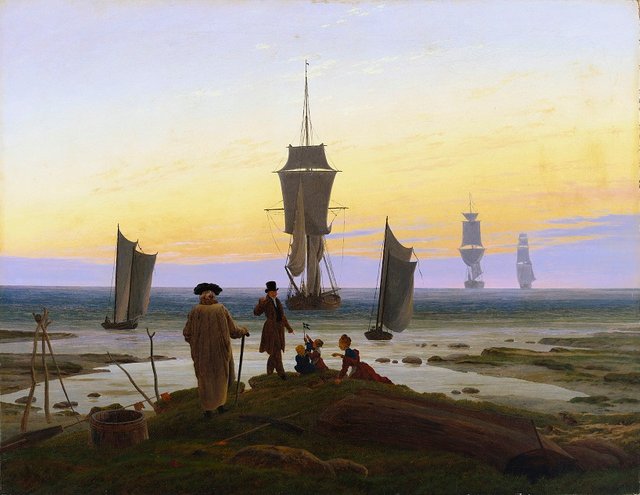[ART HISTORY] The Stages of Life (1834) by Caspar David Friedrich 🎨
In the paintings of Caspar David Friedrich (1774–1836) the spectator himself is often part of the image. In one painting two men observe the moon together; in another a lonely woman with open arms faces a sunset; in another we see a couple in the bow of a boat gazing at the horizon. Friedrich usually only shows their backs and thus he makes them into some sort of doppelgangers of the viewers that stand in front of the paintings. We are pulled into the paintings due to the back-facing figures. They become us, and we become them.
Everything in a Friedrich painting is still, as if frozen in the moment. Even the heeling ships in his sea paintings, the horses playing in a field, or the owls with extended wings that recur in many of his drawings, all seem to be frozen in the middle of the movement. Time has ceased or turned into internal time, that which we experience when we face the mysterious. But Friedrich is by no means an obscure or diffuse painter. The power of suggestion rather lies within his clarity and hypersensitivity; he paints the light, the colors, the trees, the vegetation, the mountains and the objects with tremendous precision. Reality is inspired with magic because it's reproduced as the senses perceive it. Although, there's a rich symbolism in his paintings - not least Christian themes of sacrifice and death symbolism - but it's usually subordinate to the here-and-now of the images. To regard a Friedrich landscape is to become more present, as if being sucked into nature itself.

The allegorical painting "The Stages of Life" (1834) belongs to Friedrich late works, with five people and five respective ships that symbolically represent different life stages and the passing of life. It's probably his most obviously allegorical and symbolic painting. The small fishing boats and the three larger ships represent Friedrich himself and his younger relatives. The younger adults travel at a distance, most distant from their origin and their final destination, in the middle of life. The two children are symbolized by the two small boats near the beach: their life's voyage has just begun. On the large ship in the middle which is on its way back to the shore, the sails are about to be reefed, a sign that its life journey is near its end. Its mast also resembles a crucifix. In this way the five ships correspond to the five people on the shore. The old man with the cane that we only see the back of, and that is gazing toward the sea, is Friedrich himself. The young boy is his son Gustav Adolf (named after the Swedish king), the girls next to him are Friedrich's daughters Agnes and Emma. The man with a top hat is modeled after his nephew Johann Heinrich.
Beyond all spiritual references and allegorical themes, the painting fascinates in a more direct way through the perfection of its clear and balanced composition, its picturesque qualities and the transfiguring charm of its color palette. A lilac horizon divides the image into two halves. The upper half is dominated by yellow tones, while the lower half predominantly shows dark and earthy tones. Originally the painting was called "Strandszene in Wiek" (Beach scene in Wiek) and the title "The Stages of Life" (Die Lebensstufen) didn't originate from Friedrich himself. A curiosity is that the little boy is proudly waving a Swedish flag. At the time of Friedrich's birth in 1774, his birthplace Greifswald (today northeastern Germany) had belonged to Swedish Pomerania for over 140 years. A universal masterpiece and a timeless classic, beyond "romanticism", "symbolism" or any other period or genre.

Hello @steemswede,
Congratulations! Your post has been chosen by the communities of SteemTrail as one of our top picks today.
Also, as a selection for being a top pick today, you have been awarded a TRAIL token for your participation on our innovative platform...STEEM.
Please visit SteemTrail to get instructions on how to claim your TRAIL token today.
If you wish to not receive comments from SteemTrail, please reply with "Stop" to opt out.
Happy TRAIL!

Nice discussion of an interesting painting. I enjoyed the read. Thanks.
Glad you enjoyed, thanks!
This post has been ranked within the top 50 most undervalued posts in the second half of Mar 05. We estimate that this post is undervalued by $3.87 as compared to a scenario in which every voter had an equal say.
See the full rankings and details in The Daily Tribune: Mar 05 - Part II. You can also read about some of our methodology, data analysis and technical details in our initial post.
If you are the author and would prefer not to receive these comments, simply reply "Stop" to this comment.
I always think os Salvador Dali when I look at this one